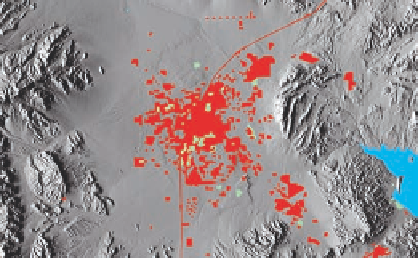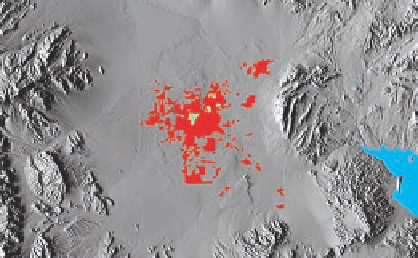Environmental Engineering Reference
In-Depth Information
ronmental problems in the United States have been re-
duced significantly. Most people have better working
and housing conditions, and air and water quality
have improved. Better sanitation, public water sup-
plies, and medical care have slashed death rates and
the prevalence of sickness from malnutrition and
infectious diseases. Concentrating most of the popula-
tion in urban areas has also helped protect the coun-
try's biodiversity by reducing the destruction and
degradation of wildlife habitat.
However, a number of U.S. cities—especially
older ones—have
deteriorating services
and
aging in-
frastructures
(streets, schools, bridges, housing, and
sewers). Many face
budget crunches
from rising costs as
some businesses and people move to the suburbs or
exurbs areas and reduce revenues from property taxes.
There is also
rising poverty
in the centers of many older
cities, where unemployment rates are typically 50% or
higher.
surrounding countryside—frequently prime farmland
or forests—and increases dependence on cars. The
result is a far-flung hodgepodge of housing develop-
ments, shopping malls, parking lots, and office com-
plexes—loosely connected by multilane highways and
freeways. Urban sprawl is the product of increased
prosperity, ample and affordable land, automobiles,
cheap gasoline, and poor urban planning.
Figure 7-17 (p. 144) shows some of the undesirable
consequences of urban sprawl. Sprawl has increased
travel time in automobiles, decreased energy efficiency,
increased urban flooding problems, and destroyed
prime cropland, forests, open space, and wetlands. It
has also led to the economic death of many central
cities.
To pay for heavily mortgaged houses and cars,
adults in a typical suburban family spend most of their
nonworking hours driving to and from work or run-
ning errands over a vast suburban landscape. Many
have little energy and time left for their children or
themselves, or getting to know their neighbors. On the
other hand, many people prefer living in sprawling
exurbs that are not dependent on a central city for jobs,
shopping, or entertainment.
Urban Sprawl
Where land is ample and affordable, urban areas tend
to sprawl outward, swallowing up the surrounding
countryside.
A major problem in the United States and some other
countries with lots of room for expansion is
urban
sprawl
(Figure 7-16). Growth of low-density develop-
ment on the edges of cities and towns gobbles up the
Examine how the San Francisco Bay area grew in popula-
tion between 1900 and 1990 at Environmental ScienceNow.
1952
1967
Figure 7-16
Natural
capital degradation:
urban sprawl
in and
around Las Vegas,
Nevada, 1952-1995.
Between 1970 and
2004, the population
of water-short Clark
County (which includes
Las Vegas) more than
quadrupled from
463,000 to 2 million.
This growth is expected
to continue.
1972
1995










